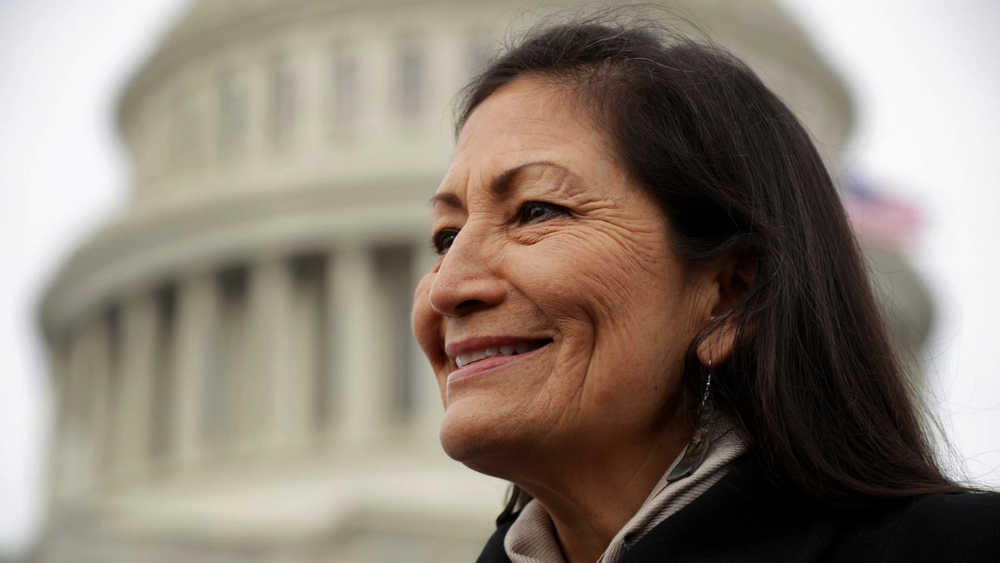In the American West, a ration of reverence is usually given to the grizzled Anglo rancher who rises at a public hearing and announces that his people have been on the land for five generations. So what are we to make of Rep. Deb Haaland, a citizen of the Laguna Pueblo, who says that her people have been in the Rio Grande Valley of New Mexico for 35 generations — dating to the 13th century?
“Native history is American history,” she told me. “Regardless of where you are in this country now, you’re on ancestral Indian land, and that land has a history.”
As Joe Biden’s choice for interior secretary, Haaland is poised to make a rare positive mark in the history of how a nation of immigrants treated the country’s original inhabitants. She would be the first Native American cabinet secretary — a distinction that has prompted celebration throughout Indian Country. “I haven’t been the one making policy,” she said. “But I’ve been the one on the receiving end of it.”
There will be plenty of sniping, second-guessing and disappointment among the tribes by people who expect much of Haaland having a seat at the big table. But for now, we should let this moment breathe.
I spoke to her on the anniversary of a day of infamy. On December 29, 1890, the US army slaughtered men, women and children at Wounded Knee in South Dakota. Government policy was to strip Indians of their language, culture and religion, with children sent off to boarding schools where they were taught that the old ways were wrong. At the end of the 19th century, the popular view was that indigenous people would soon disappear. And yet here is Haaland, one of more than five million Native Americans, ready to knock down some of the last barriers of time and terrain in this country.
Her personal story alone makes Haaland an anomaly in the parlours of power. Soon after graduating from college, she became a single mother. She was sometimes dependent on food stamps, and she once ran a small business selling homemade salsa to make a living and support her child. As a freshman representative in 2019, she was still paying off her student loans.
When she ran for office, her slogan was, “Congress has never heard a voice like mine.” Now the person with that voice could soon be overseeing one-fifth of the land in the United States of America.
As interior secretary, her portfolio would include national parks, wildlife refuges, the US Geological Survey and the vast acreage of the Bureau of Land Management. Interior, for good reason, is known as the Department of Everything Else.
As such, she would also be overseeing millions of acres taken from Indians in treaties broken over the past several centuries, and would be the top government liaison with 574 federally recognized tribes — the nations within a nation.
This is quite the compass — from a deep slot in the earth near the Grand Canyon, wherein dwell the Havasupai, to the rainforest of the Olympic Peninsula, home of the Makah Nation, to urban neighbourhoods that house Indians struggling with healthcare access.
“I wish we could right some wrongs,” she said of the centuries-old saga of sorrow. But she seems content to try to right the many wrongs that Donald Trump’s administration has inflicted on the land.
Trump’s first interior secretary, Ryan Zinke, literally rode into office on a horse named Tonto and then promptly launched a campaign to make it easier to drill on public land. The current secretary, David Bernhardt, was an oil and gas lobbyist whose public service on behalf of his former clients was warmly received by his old friends.
Biden has pledged to end all new oil and gas drilling on these rangelands, forests and plains — an enormous change that will be fought fiercely by those who profit from land owned by all Americans. He has also promised to restore Bears Ears National Monument — a marvel of sandstone, mountains and Native sacred sites in the Southwest — that was gutted by Trump, who reduced the size of the protected area by 85 per cent.
Haaland is eager for the opportunity to do something lasting. “I’ll be fierce for all of us, for our planet and all of our protected land,” she said in December.
But it’s the weight of Native history that makes the choice of Haaland so extraordinary, as she acknowledged. “This moment is profound when we consider the fact that a former secretary of the interior once proclaimed it his goal to, quote, ‘civilize or exterminate’ us’.” She was referring to Alexander H.H. Stuart, the secretary of the interior in the early 1850s, in the Fillmore administration.
“Exterminate” was no exaggeration. The census of 1900 counted more than 237,000 Native Americans, a population collapse of nearly 90 per cent in the estimate of many ethnohistorians, from the time of first European contact.
Some of the atrocities are well known. But less well known is how the government made it a crime for Natives to practise their religion. It was a violation of the First Amendment to lock people up for enacting the rituals of faith — unless they worshipped Native gods through certain dances and ceremonies deemed criminal by the government.
A consistent plea from Indian Country today is a request that fellow Americans consider Native people as much more than living relics locked in a tragic past. Haaland aims to ensure that. “I’ll never forget where I came from,” she said. But, she added, “ I love this opportunity.” Even if she can’t reverse history, she is poised to make some.
New York Times News Service










